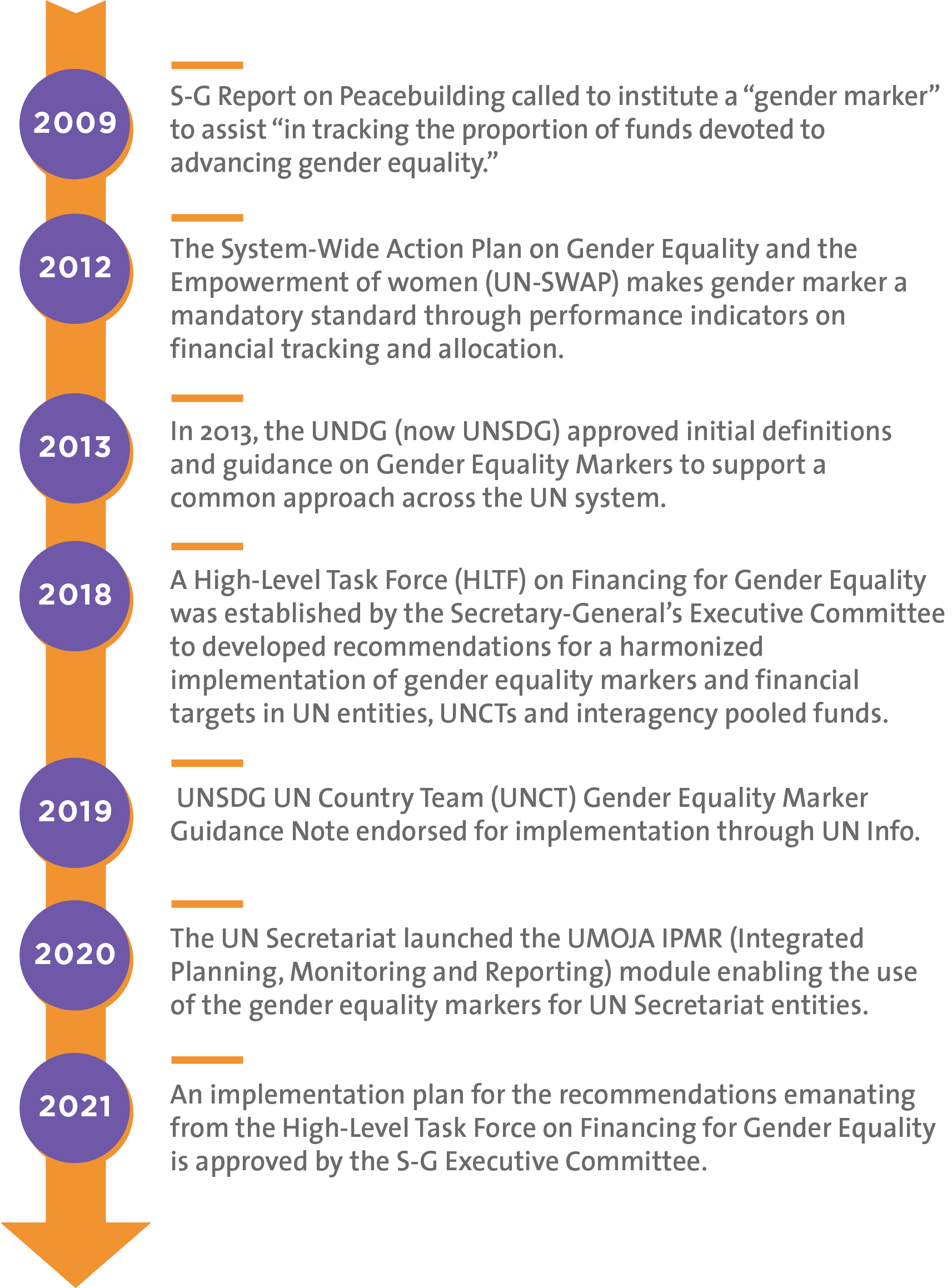Financing for gender equality is a necessary foundation for achieving gender equality and the em-powerment of women and girls.
Module 1 introduces key concepts and explains the rationale for implementing Gender Equality Marker Systems. It also gives an insight into the history of Gender Equality Markers in the UN System.
1.1 Gender Equality Markers & the UN System: A Chronology
Financing for gender equality is a necessary foundation for achieving gender equality and the em-powerment of women and girls. It refers to increasing the quantity and quality of financial re-sources for gender equality so that normative commitments can be integrated into laws, policies, plans and budgets as well as implemented to achieve tangible results for women and girls.
Beginning in 2010, the Peacebuilding Fund and a few of the UN Funds and Programmes (UNDP, UNFPA and UNICEF) piloted the use of the gender equality marker (GEM) in response to the Secre-tary-General’s Seven Point Action Plan. In this Plan, the Secretary- General called for at least 15% of UN-managed funds in support of peacebuilding to be dedicated to projects whose principal objec-tive is to address women’s specific needs as well as to advance gender equality and the empower-ment of women.
By 2012, the gender equality marker as well as the setting of financial targets on gender equality became mandatory standards under the System-wide Action Plan on Gender Equality and the Em-powerment of Women (UN-SWAP). They continue to be mandated annually by the Economic and Social Council (ECOSOC) in its resolutions on mainstreaming a gender perspective into all policies and programmes in the United Nations system as well as in General Assembly resolutions on the Quadrennial Comprehensive Policy Review (QCPR). Through the UN System-Wide Action Plan on Gender Equality and the Empowerment of Women (UN-SWAP), which has transformed the way in which gender equality work is carried out in the UN system, several entities developed gender policies as well as integrated gender equality in their strategic plans and results-based management systems. These policies and plans have helped entities to better prioritize gender equality in their work using a twin-track approach to gender mainstreaming, which combines a mix of dedicated gender equality interventions with integrated approaches in programme portfolios and budgets.
In 2013, the United Nations Development Group (now the United Nations Sustainable Development Group (UNSDG)) approved initial definitions and guidance on Gender Equality Markers to support a common approach across the UN system for the purposes of comparability. The guidance was further updated in 2018 when the CEB Finance and Budget network endorsed guidance on coding definitions and quality assurance for gender equality markers.
In 2018 the Secretary-General’s Executive Committee convened a High-Level Task Force (HLTF) on Financing for Gender Equality to address the persistent under-resourcing of the gender equality agenda. The HLTF was tasked with reviewing and tracking budgets and expenditures across the UN system and making recommendations on how to increase financing for gender equality, including by identifying structural and operational changes required to enable financial tracking. The HLTF adopted six recommendations aimed at increased coordination, consistency and comparability across the UN-System and at complementing the Secretary-General’s Strategy for Financing the 2030 Agenda for Sustainable Development. Key objectives include harmonizing gender equality markers and financial targets and increasing funding for gender-related programming.
In 2023, CEB-endorsed the Data standards for United Nations System-wide reporting of financial data with the gender marker as the 7th standard. This standard is being applied system-wide with a transitionary period of 3 years.

1.2 Key Concepts and Definitions
Key concepts underpinning gender equality markers include:
Empowerment of women and girls concerns their gaining power and control over their own lives. It involves awareness-raising, building self-confidence, expansion of choices, increased access to and control over resources and actions to transform the structures and institutions which reinforce and perpetuate gender discrimination and inequality. This implies that to be empowered they must not only have equal capabilities (such as education and health) and equal access to resources and opportunities (such as land and employment), but they must al-so have the agency to use these rights, capabilities, resources and opportunities to make stra-tegic choices and decisions (such as is provided through leadership opportunities and participa-tion in political institutions).
Gender “refers to the roles, behaviours, activities, and attributes that a given society at a given time considers appropriate for men and women. In addition to the social attributes and oppor-tunities associated with being male and female and the relationships between women and men and girls and boys, gender also refers to the relations between women and those between men. These attributes, opportunities and relationships are socially constructed and are learned through socialization processes. They are context/ time-specific and changeable. Gender de-termines what is expected, allowed and valued in a woman or a man in a given context. In most societies there are differences and inequalities between women and men in responsibilities as-signed, activities undertaken, access to and control over resources, as well as decision-making opportunities. Gender is part of the broader socio-cultural context, as are other important cri-teria for socio-cultural analysis including class, race, poverty level, ethnic group, sexual orienta-tion, age, etc.” (See UN Women, Gender Equality Glossary)
Gender Analysis is a critical examination of how differences in gender roles, activities, needs, opportunities and rights/entitlements affect men, women, girls and boys in certain situation or contexts. Gender analysis examines the relationships between females and males and their ac-cess to and control of resources and the constraints they face relative to each other. A gender analysis should be integrated into all sector assessments or situational analyses to ensure that gender-based injustices and inequalities are not exacerbated by interventions, and that where possible, greater equality and justice in gender relations are promoted.
Gender Equality refers to the equal rights, responsibilities and opportunities of women and men and girls and boys. Equality does not mean that women and men will become the same but that women’s and men’s rights, responsibilities and opportunities will not depend on whether they are born male or female. Gender equality implies that the interests, needs and priorities of both women and men are taken into consideration, recognizing the diversity of dif-ferent groups of women and men. Gender equality is not a women’s issue but should concern and fully engage men as well as women. Equality between women and men is both a human rights issue and a precondition for, and indicator of, sustainable people-centered development.
Gender Equality Results are the results achieved for women compared with men, including participation in project or programme activities, access to project/programme and other re-sources, practical benefits, and strategic changes in gender relations. Gender equality results may be immediate or process results, intermediate results or outputs, or long-term results or outcomes.
Gender Mainstreaming is the process of assessing the implications for women and men of any planned action, including legislation, policies or programs, in any area and at all levels. It is a strategy for making the concerns and experiences of women as well as of men an integral part of the design, implementation, monitoring and evaluation of policies and programs in all politi-cal, economic and societal spheres, so that women and men benefit equally, and inequality is not perpetuated. The ultimate goal of mainstreaming is to achieve gender equality.” (See UN Economic and Social Council Resolution 1997/2: Agreed Conclusions)
Gender-sensitive Indicators are indicators that track gender-related changes over time. They point to changes in the status and roles of women and men/girls and boys over time and how a project or intervention affects them. A key element of a results framework is the indicators that are selected to measure progress on delivering outputs and achieving outcomes and impact to include both age and gender-sensitive as well as sex-specific/sex-disaggregated qualitative and quantitative indicators or data collection methods. Without this information it is difficult to monitor progress on advancing gender equality or women’s empowerment.
Financial resource tracking involves the ability to track financial disbursements and expendi-tures. Such tracking is generally done through the introduction of tagging (e.g., a gender equali-ty marker) in financial resource tracking systems. Financial resource tracking supports quantify-ing or providing an indicative measure of the UN’s financial support for gender equality; to as-sess the extent to which gender commitments are translated into investments; and encourage increased discussion of how to improve the gender responsiveness of projects and programs supported by the UN system.
Financial target is the planned share of budget dedicated to gender equality and the empow-erment of women. The target can be set on project, programme, fund and on entity level.
Coding / marking / tagging are actions often used interchangeably to describe the assigning of a value to an activity, output, outcome, and/or project / programme.
Additional Resources
UN Women, Gender Equality Glossary
UNICEF, Glossary of Terms and Concepts
Key acronyms in the context of Gender Equality / Gender Equality Markers:
- ERP - Enterprise Resource Planning
- GEWE - Gender Equality and Women’s Empowerment
- GEM - Gender Equality Marker
- GAM - Gender with Age Marker
- GM - Gender Mainstreaming
- UN-SWAP - System Wide Action Plan on Gender Equality and the Empowerment of Women
- IPMR - Integrated Planning, Management and Reporting
- MPTF - Multi-Partner Trust Fund
- UNDG - United Nations Development Group (now the United Nations Sustainable Development Group -UNSDG-)
For acronyms on UN entities, please see the organizational chart.
